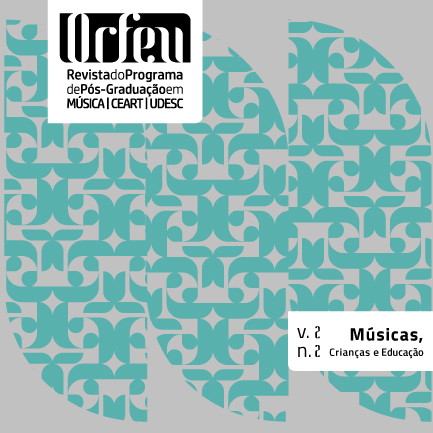The pedagogy of musical creation today: from early childhood to adolescence and beyond
DOI:
https://doi.org/10.5965/2525530402022017013Keywords:
Childhood, Music, InventionAbstract
Musical creation, which 70 years ago was practiced only by professional musicians, is today accessible to amateurs and children. It can be their first musical experience, and the basis of an education. Study of compositional strategies shows that at the heart of the creative process is a “musical idea”. What is a “musical idea”? It is an interesting sound which attracts the attention of the musician and makes him want to extend it. To extend the discovery, the composer repeats it with variations. The musical idea, which a century ago was usually a theme or motif, is today more commonly a particular sonority. Repeating a distinctive sound and varying it, however, is typical of the sound-exploration behavior of early childhood, known as “circular reaction”. Thus, from childhood, it is possible to encourage exploratory behavior, which becomes invention once it is intentional. This behavior can be enriched by the dimension of symbols and afterward by a taste for creating. The child goes through the different forms of game-playing, as analyzed by Piaget: the sensorimotor game, the symbolic game, and the rule-based game. The role of the educator is then to stimulate and guide this spontaneous development. Certain equipment can help. After the age of about 9 or 10, the computer is a suitable tool for composition.
Downloads
References
BLACKING, J. How musical is man? Seattle, London: University of Washington Press, 1973.
BUCI-GLUCKSMANN, C.; LÉVINAS, M. (Dir.). L’idée Musicale. Saint-Denis: Presses Universitaires de Vincennes, 1993.
DELALANDE, F. La musique est un jeu d’enfant. Paris: Ina/Buchet-Chastel, 1984
DELALANDE, F. Éléments d’analyse de la stratégie de composition. In: Actes du colloque : structures musicales et assistance informatique 1-4 juin 1988. Marseille: MIM, CNR, 1989. p. 51-65.
DELALANDE, F. Toward an Analysis of Compositional Strategies. Circuit, Montréal, v. 17, n.1, p.11-26, 2007.
DELALANDE, F. Le son des musiques, entre technologie et esthétique, Paris: Ina/Buchet-Chastel, 2001.
DELALANDE, F. et al. Naissance de la musique, les explorations sonores de la première enfance. Rennes: PUR, Ina-éditions, 2015.
DONIN, N.; TRAUBE, C. (Dir.): Tracking the creative process in music. Musicæ Scientiæ, v. 20, n. 3, numéro special, Septembre 2016.
PETERSON, R. A. Mais pourquoi donc en 1955? Comment expliquer la naissance du rock. In: MIGNON, P. et HENNION, A. (Ed), Rock, de l’histoire au mythe. Paris: Anthropos, 1991.
PIAGET, Jean. O nascimento da inteligência na criança. Rio de Janeiro: LTC, 1978.
POUTS-LAJUS, S.; TIÉVANT, S.; JOY, J.; SEVIN, J.-C. Composer sur son ordinateur. Les pratiques musicales en amateur liées à l’informatique. Les travaux du DEP. Ministère de la Culture et de la Communication (France), 2002. Disponível em: <http://www2.culture.gouv.fr/culture/deps/2008/pdf/tdp_ordinat.pdf>
ZIEGFIELD, E. (Dir.). Art et éducation. Paris: Unesco, 1954.
Downloads
Published
How to Cite
Issue
Section
License
Copyright (c) 2017 ORFEU

This work is licensed under a Creative Commons Attribution 4.0 International License.
Authors who submit their manuscripts to be published in this journal agree to the following terms:
1. Authors retain the copyright and grant to the journal the right of first publication, whilst simultaneously permitting their work to be licensed under the Creative Commons License Attribution, which allows the sharing of work with recognition of the authorship and initial publication in this journal.
2. Contributions in this journal are open access; this means they are based in free use, and non-commercial applications.






